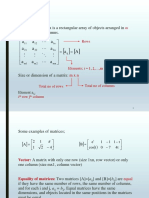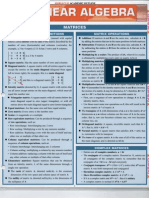0% found this document useful (0 votes)
16 views16 pagesLecture 0
The document covers fundamental concepts in linear algebra, including matrices, their types, and operations such as addition, scalar multiplication, and matrix multiplication. It also discusses properties of determinants, the rank of matrices, and the nature of solutions for linear systems. Additionally, it highlights the significance of positive definite matrices in various applications like optimization, statistics, and machine learning.
Uploaded by
sohindosCopyright
© © All Rights Reserved
We take content rights seriously. If you suspect this is your content, claim it here.
Available Formats
Download as PDF, TXT or read online on Scribd
0% found this document useful (0 votes)
16 views16 pagesLecture 0
The document covers fundamental concepts in linear algebra, including matrices, their types, and operations such as addition, scalar multiplication, and matrix multiplication. It also discusses properties of determinants, the rank of matrices, and the nature of solutions for linear systems. Additionally, it highlights the significance of positive definite matrices in various applications like optimization, statistics, and machine learning.
Uploaded by
sohindosCopyright
© © All Rights Reserved
We take content rights seriously. If you suspect this is your content, claim it here.
Available Formats
Download as PDF, TXT or read online on Scribd
/ 16
























































































